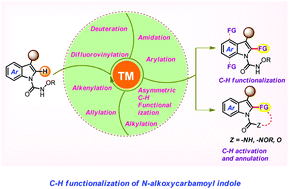The C–H functionalization of N-alkoxycarbamoyl indoles by transition metal catalysis
Abstract
Indole and its congeners are ubiquitous nitrogen-containing organic scaffolds present in a plethora of natural products, marketed drugs, and other organic functional molecules. Recent years have witnessed tremendous advances in the diversification of this motif and its biological applications via transition-metal-catalyzed auxiliary assisted site-selective inert C–H functionalization. In this burgeoning field, N-methoxy/ethoxy/pivaloxy amide functionality has emerged as a most potent auxiliary/DG (directing group) for a wide range of C–C and C–heteroatom bond formations, providing a new advance for forging structurally fabricated polycyclic indole frameworks. This review aims to highlight evolved transformations, like arylation, alkylation, alkenylation, allylation, amidation, difluorovinylation, deuteration, hydroarylation, etc., and the applications of N-alkoxycarbamoyl indole derivatives made within the period of 2014–August 2021. Additionally, explicit mechanistic underpinnings have also been provided in the appropriate places.

- This article is part of the themed collection: Synthetic methodology in OBC


 Please wait while we load your content...
Please wait while we load your content...